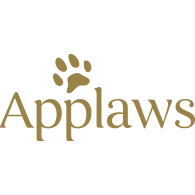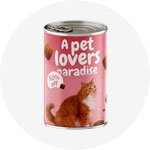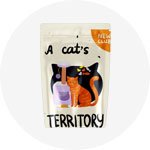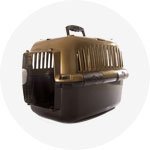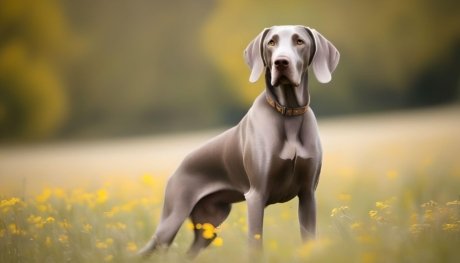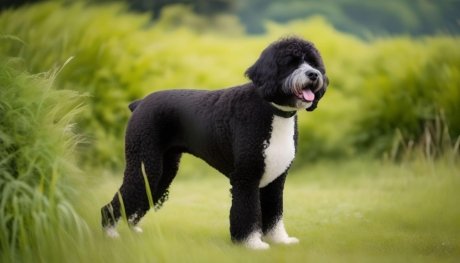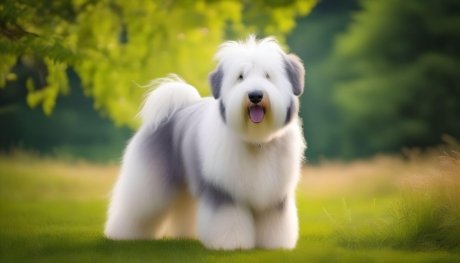Xoloitzcuintli Dog | Breed Profile, 7 Types, Prices, Facts, Care Tips
The Xoloitzcuintli, often known as the Mexican Hairless Dog or “Xolo,” is an ancient and captivating breed with a history spanning over three millennia. This unique canine companion is celebrated for its distinct hairless or coated appearance and cherished for its loyalty and affection. In this article, we’ll uncover the Xoloitzcuintli’s intriguing journey from ancient Mesoamerican civilizations to its present-day popularity as a beloved pet. Join us as we explore the history, characteristics, and the irresistible charm of the Xoloitzcuintli.
Xoloitzcuintli Dog (Mexican Hairless Dog)
The Xoloitzcuintli, often referred to as the Mexican Hairless Dog or Xolo, is a remarkable and ancient dog breed with a fascinating history. This breed has been around for over 3,000 years, making it one of the oldest in the world. Its name combines “Xolotl,” an Aztec god, and “itzcuintli,” meaning dog in Nahuatl, the Aztec language. The Xoloitzcuintli Dog was highly regarded by ancient Mesoamerican civilizations like the Aztecs and Maya, often associated with mystical and healing properties. They were even used in sacred ceremonies and as companions to the deceased, believed to guide them in the afterlife.

Physically, Xolos are known for their distinct hairless skin, although a coated variety exists as well. They come in three sizes—toy, miniature, and standard—offering a range of choices for potential owners. The skin is typically dark, and its texture can vary from smooth to slightly wrinkled. Some Xolos may have small tufts of hair on their heads or tails, adding to their unique charm.
In terms of temperament, Xoloitzcuintlis are known for their affectionate and loyal nature. They form strong bonds with their owners and make excellent family dogs. They’re intelligent and trainable, adapting well to different living situations. While they might seem reserved around strangers, Xolos are protective of their families, making them effective watchdogs.
When it comes to care, their hairless coat requires minimal grooming. However, their exposed skin is vulnerable to sunburn, so applying sunscreen or providing shade when outdoors is important. Due to their ancient lineage, Xolos are generally healthy dogs, but, like any breed, they may have specific health concerns, necessitating regular veterinary check-ups.
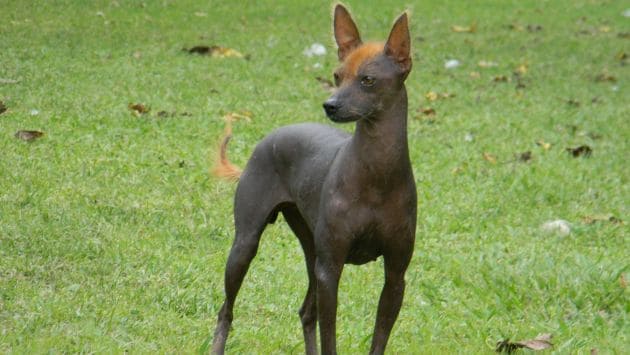
In recent years, the Xoloitzcuintli Dog has gained popularity as a unique and exotic pet. Their distinctive appearance and intriguing history have attracted dog enthusiasts worldwide. Enthusiasts and responsible breeders work diligently to promote and preserve the breed, ensuring that these remarkable dogs continue to thrive.
Characteristics of Xoloitzcuintli Dogs
Here’s the Characteristics and information about Xoloitzcuintli dogs:
| Characteristic | Description |
|---|---|
| Appearance | Hairless variety: Smooth skin with minimal hair. Coated variety: Short, flat coat. |
| Body Structure | Lean and elegant build with a graceful appearance. |
| Temperament | Affectionate, loyal, protective, calm, and well-mannered. |
| Intelligence | Intelligent, quick learners, excelling in obedience. |
| Alertness | Alert, aloof around strangers, reserved initially. |
| Barking Tendency | Low barking tendency, suitable for apartment living. |
| Maintenance | Hairless Xolos require skin care, including sunscreen and moisturizers. Coated Xolos have an easy-to-maintain coat. |
| Health | Generally healthy with a long lifespan, but prone to hip dysplasia and patellar luxation. |
| Ancient History | One of the oldest and rarest dog breeds, with a history dating back over 3,000 years in Mexico. |
| Versatility | Excel in dog sports and activities like agility and obedience competitions. |
| Hypoallergenic | Hairless variety can be a good choice for people with allergies. |
Xoloitzcuintli Puppies
Xoloitzcuintli puppies are a sight to behold, embodying the unique characteristics of their breed from an early age. Whether hairless or coated, these puppies often display their distinctive features right from birth. They are born with their unmistakable skin, and as they grow, they develop into affectionate and loyal companions. Early socialization and training are essential to help them become well-adjusted adult dogs.
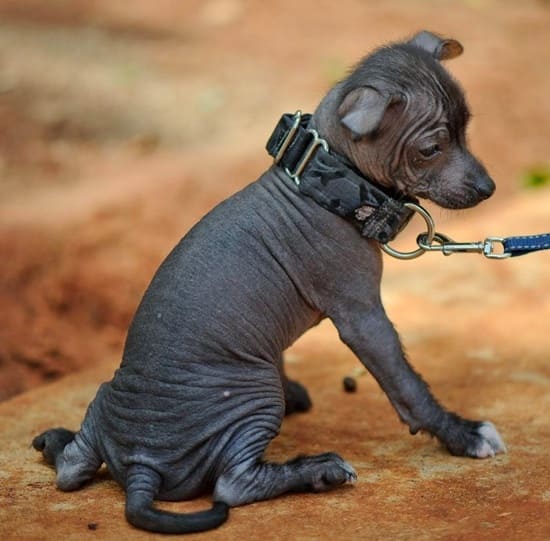
Coated Xoloitzcuintli
Coated Xoloitzcuintli Dog is the variety of this breed that possesses a short, flat coat. This coat can come in various colors, including black, gray, and brown. While they don’t have the hairless appearance that the breed is famous for, coated Xolos retain the same lovable temperament and intelligence, making them a unique choice for dog enthusiasts.
Xoloitzcuintli With Hair
Xoloitzcuintli with hair refers to the coated version of the breed. These dogs have a short, sleek coat that is easy to maintain. Their coat colors can vary, including white, black, and everything in between. They offer a different aesthetic compared to their hairless counterparts but still embody the essence of the Xoloitzcuintli breed.
Aztec Xoloitzcuintli
The Aztec Xoloitzcuintli played a central role in Aztec culture. These dogs were considered sacred, often participating in important ceremonies and rituals. They were believed to have mystical powers, and their presence was thought to aid the deceased in their journey to the afterlife. The Aztec Xoloitzcuintli carries a deep historical significance in Mesoamerican civilizations.
Mini Xoloitzcuintli
Mini Xoloitzcuintli dogs are the smaller members of the breed. Their compact size makes them suitable for individuals or families living in smaller spaces. Despite their smaller stature, they retain the loyalty and unique characteristics that define the Xoloitzcuintli breed, making them delightful companions.
Standard Xoloitzcuintli
The standard Xoloitzcuintli is the most common size within the breed. These dogs are versatile, adapting well to various living situations, from apartments to larger homes. They maintain the breed’s distinctive traits, including their affectionate nature, intelligence, and distinctive appearance.
Xoloitzcuintli Chihuahua
The Xoloitzcuintli Chihuahua mix combines the features of both breeds. These dogs are typically small in size and can have either a hairless or coated coat, depending on the genetic inheritance from their Xoloitzcuintli and Chihuahua parent breeds. They are often charming and make affectionate companions.
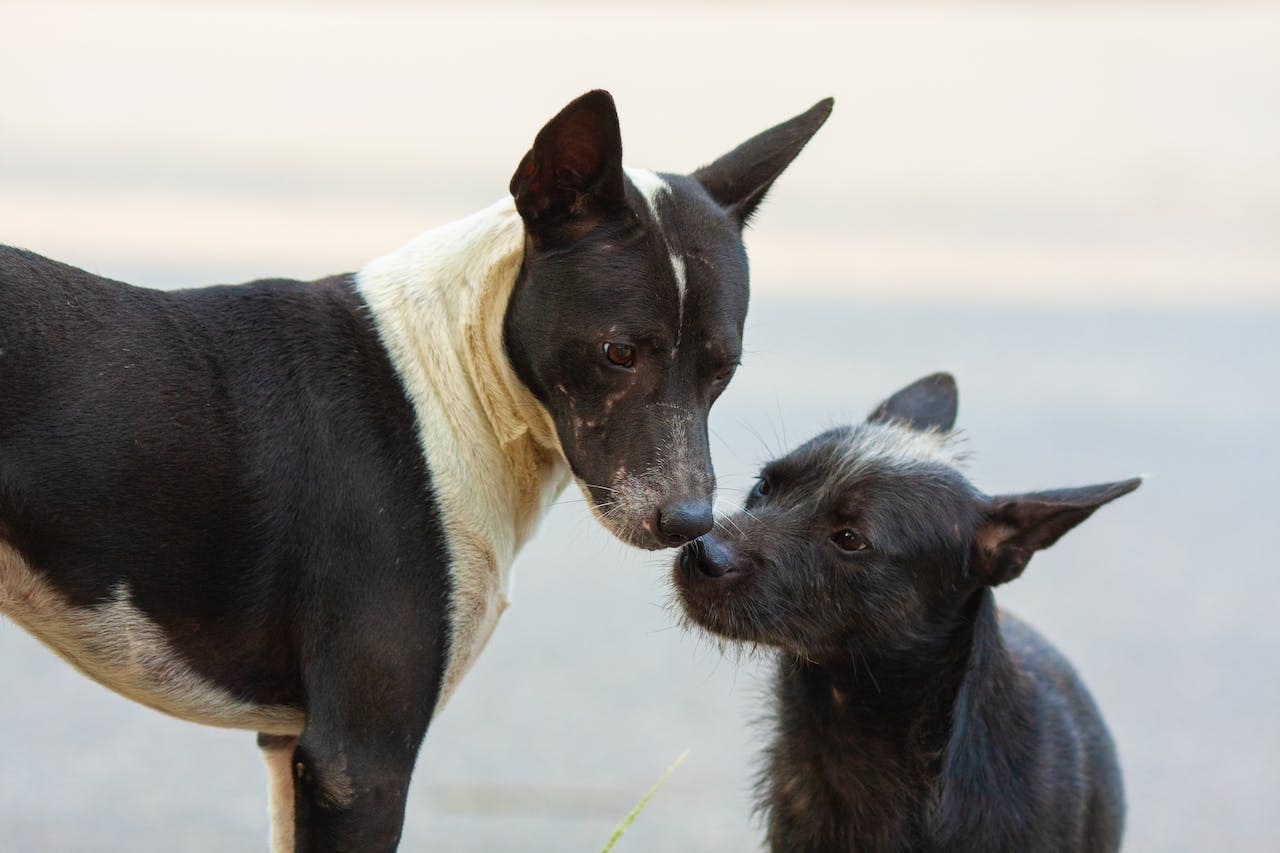
Egyptian Dog Xoloitzcuintli
The Xoloitzcuintli Dog’s appearance has often drawn comparisons to dogs depicted in ancient Egyptian art and hieroglyphs. Although the breed’s roots are in the Americas, the term “Egyptian dog Xoloitzcuintli” reflects the visual similarities and historical connections to Egyptian dog depictions.
Black Xoloitzcuintli
Black Xoloitzcuintli dogs are a less common but striking variety within the breed. Their dark black skin sets them apart from the more common colors. These dogs are highly sought after by enthusiasts who appreciate the unique features of the Xoloitzcuintli in this distinct hue.
Xoloitzcuintli Coco Dog
The term “Coco dog” gained prominence with the release of the Disney-Pixar movie “Coco,” which celebrates Mexican culture, including the significance of the Xoloitzcuintli in Mexican traditions, especially during Dia de los Muertos (Day of the Dead) festivities. The Coco dog, inspired by real-life Xoloitzcuintlis, holds a cherished place in Mexican culture and is a symbol of remembrance and respect for loved ones who have passed away.
Peruvian Inca Orchid Vs Xoloitzcuintli
Here is a comparison and differences between the Peruvian Inca Orchid and the Xoloitzcuintli Dog:
| Characteristic | Peruvian Inca Orchid | Xoloitzcuintli (Mexican Hairless Dog) |
|---|---|---|
| Origin | Peru | Mexico |
| Size | Small to Medium | Toy, Miniature, Standard |
| Coat Type | Hairless and Coated Varieties | Hairless and Coated Varieties |
| Coat Colors | Various, including solid and spotted | Various, including solid and spotted |
| Temperament | Affectionate, loyal, and gentle | Affectionate, loyal, and intelligent |
| Activity Level | Moderate to High | Moderate to High |
| Intelligence | Highly intelligent | Highly intelligent |
| Trainability | Eager to learn and responsive | Eager to learn and responsive |
| Socialization | Requires early socialization | Requires early socialization |
| Health | Generally healthy, but may be prone to skin issues | Generally healthy, but may have specific health concerns |
| Lifespan | 12 to 14 years | 12 to 15 years |
| Purpose | Companion and therapy dog | Companion and therapy dog |
| Ancient Heritage | Associated with Inca civilization | Associated with Aztec and Maya civilizations |
| Popularity | Gaining recognition worldwide | Gaining popularity worldwide |
Types of Polydactyl Dogs
Polydactyl dogs are those with more than the typical number of toes on their paws. While most dogs have four toes on their front paws and four on their hind paws, polydactyl dogs exhibit variations in the number of toes. There are several types of polydactyl dogs, each with its own unique characteristics. Here are some examples:
- Labrador Polydactyl Dogs: Labrador Retrievers are known to occasionally have polydactylism. This means they may have extra toes on one or more paws. Polydactyl Labradors typically have more than the standard number of toes on their front paws.
- American Polydactyl Dogs: American Polydactyl dogs are a breed that naturally carries a gene for polydactylism. They can have up to seven toes on each paw. This breed is known for its distinctive appearance, often featuring extra toes and webbed feet.
- Great Pyrenees Polydactyl Dogs: Great Pyrenees dogs, which are known for their large size and guarding abilities, can sometimes exhibit polydactyly. They may have additional toes on their paws, typically on the hind legs.
- Beauceron Polydactyl Dogs: The Beauceron breed, originally from France, can also have polydactyl paws. This trait is more common in certain bloodlines and can result in extra toes on one or more of their paws.
- Norwegian Lundehund: The Norwegian Lundehund is a breed known for its polydactylism. These dogs have a unique history of being bred to hunt puffins in steep cliffs, and their polydactyl toes help them with this task. They often have extra toes, which can number up to six on each paw.
- St. Bernard Polydactyl Dogs: St. Bernards, famous for their gentle and massive presence, can occasionally have polydactyl paws. This may result in additional toes, typically on the front paws.
- Mixed Breed Polydactyl Dogs: Polydactylism can occur in mixed-breed dogs as well. It’s not limited to specific breeds, and it can appear as a genetic variation in any dog with ancestors who carried the polydactyly gene.
Xoloitzcuintli Mix
A Xoloitzcuintli mix is a dog that is a crossbreed with the Xoloitzcuintli Dog, often referred to as the Mexican Hairless Dog. These mixed-breed dogs inherit characteristics from both the Xoloitzcuintli and the other breed in the mix. The resulting dog may have a hairless or coated coat, depending on the genetic influence of the Xoloitzcuintli Dog and the other parent breed. The temperament and appearance of a Xoloitzcuintli mix can vary widely, making them unique and fascinating companions.
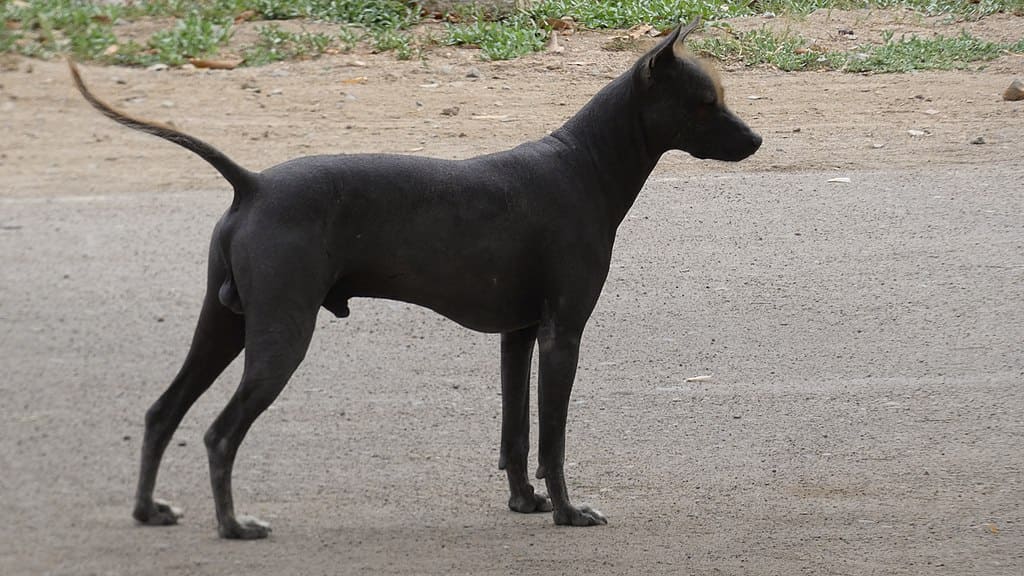
Xoloitzcuintli Chihuahua Mix
The Xoloitzcuintli Chihuahua mix combines the traits of the Xoloitzcuintli with those of the Chihuahua breed. These mixed-breed dogs typically have a small to medium size and can inherit features from both parent breeds, such as the Xoloitzcuintli’s unique appearance and the Chihuahua’s compact size. Their coat may vary, with some displaying the hairless trait of the Xoloitzcuintli, while others may have a short, smooth coat like the Chihuahua. They are known for being affectionate, loyal, and often possess a spirited personality.
Xoloitzcuintli Pitbull Mix
The Xoloitzcuintli Pitbull mix is a crossbreed that combines the Xoloitzcuintli with the Pitbull. These mixed-breed dogs can vary in size, with the outcome influenced by the size of the Xoloitzcuintli and the Pitbull parent. They may inherit the hairless characteristic of the Xoloitzcuintli or a short coat from the Pitbull. In terms of personality, they can be loyal and protective, reflecting the traits of both parent breeds. These mixed-breed dogs often make loving and devoted companions.
Xoloitzcuintli History
The Xoloitzcuintli, often referred to as the Mexican Hairless Dog, has a history that spans over 3,000 years. It is one of the oldest dog breeds in the world, with its origins traced back to ancient Mesoamerican civilizations, including the Aztecs and Maya. The name “Xoloitzcuintli” is derived from the Aztec god Xolotl and “itzcuintli,” meaning dog in Nahuatl. These dogs were highly regarded in these cultures, used in sacred ceremonies and believed to have mystical and healing powers.
Appearance of Polydactyl Dogs
Polydactyl dogs, including some Xoloitzcuintli Dogs, exhibit variations in the number of toes on their paws. These extra toes can vary in number and location. While most dogs have four toes on each paw, polydactyl dogs can have more, leading to distinctive and sometimes unusual-looking paws.

Xoloitzcuintli Temperament
Xoloitzcuintlis are known for their affectionate and loyal temperament. They form strong bonds with their owners and are excellent family dogs. They are intelligent and trainable, making them adaptable to various living situations. While they may appear reserved around strangers, they are often protective of their families, making them effective watchdogs.
Behaviour of Xoloitzcuintli
Xoloitzcuintlis exhibit behaviors that are typical of affectionate and loyal companion dogs. They are known for their strong attachment to their families, and they can be quite reserved or aloof with strangers. These dogs are intelligent, responsive to training, and have a calm demeanor. They are generally well-behaved and make great companions.
Xoloitzcuintli Mythology
Xoloitzcuintli Dogs hold a special place in the mythology and culture of ancient Mesoamerican civilizations. They were associated with the Aztec god Xolotl and were believed to have a sacred and mystical significance. These dogs were often considered spirit guides for the deceased, guiding them in the afterlife. Their unique appearance and temperament played a central role in the mythology and rituals of these ancient cultures.
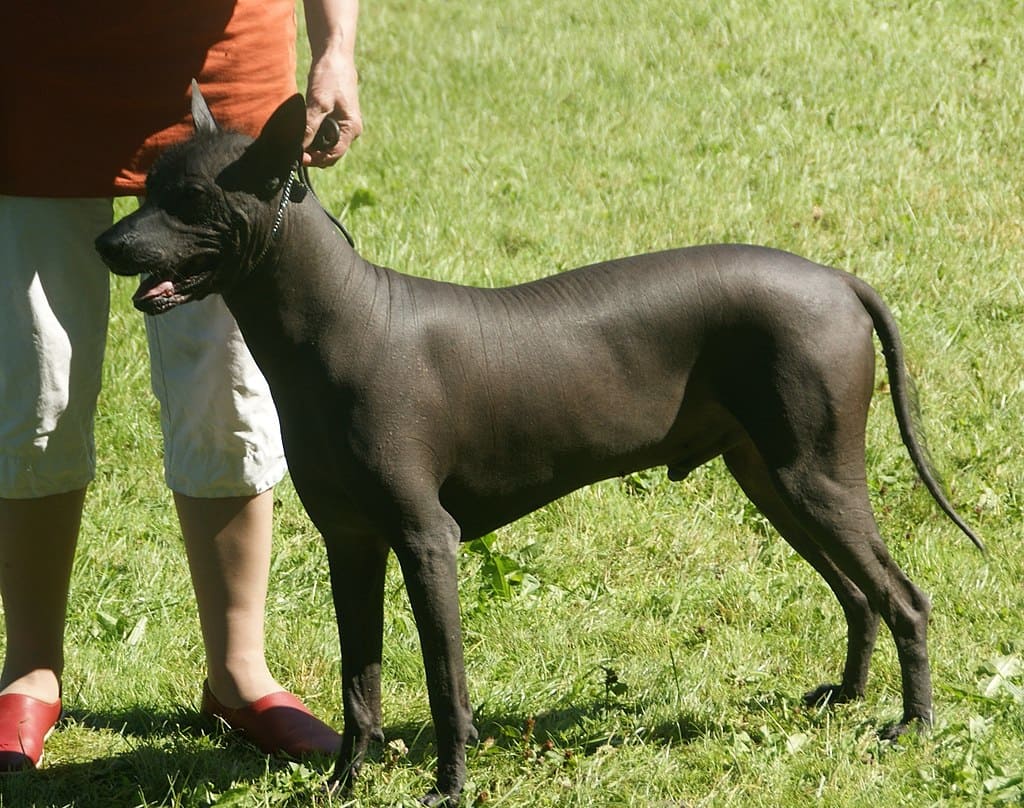
Xoloitzcuintli Pronunciation
Pronouncing “Xoloitzcuintli” can be a bit challenging for those unfamiliar with the Nahuatl language. Xoloitzcuintli is typically pronounced as “show-low-eets-queen-tlee” or “sho-lo-eets-kweent-lee.” The key is to break down the word into syllables and pronounce each part as accurately as possible.
Xoloitzcuintli Sizes
Xoloitzcuintli dogs come in different sizes, and they are often categorized into three main size classes: toy, miniature, and standard. Here’s a description of each size:
- Toy Xoloitzcuintli:
- Weight: Typically weighing between 5 to 15 pounds (2.3 to 6.8 kilograms).
- Height: Height at the withers (shoulders) is usually around 9 to 14 inches (23 to 36 centimeters).
- These are the smallest Xolos and are often considered miniature companions.
- Miniature Xoloitzcuintli:
- Weight: Generally ranging from 15 to 30 pounds (6.8 to 13.6 kilograms).
- Height: Standing at the withers at around 15 to 20 inches (38 to 51 centimeters).
- Miniature Xolos are larger than toy Xolos but still smaller than the standard variety.
- Standard Xoloitzcuintli:
- Weight: Typically weighing between 30 to 55 pounds (13.6 to 25 kilograms).
- Height: Height at the withers is usually 20 to 30 inches (51 to 76 centimeters).
- Standard Xolos are the largest of the three size classes and are considered the original size.
Xoloitzcuintli Price
The price of a Xoloitzcuintli, or Mexican Hairless Dog, can vary in the USA and India. In the USA, they typically cost between $1,000 to $3,000 from reputable breeders. In India, Xoloitzcuintli puppies may be available for around INR 15,000 to INR 50,000 or more. It’s important to choose a responsible breeder or consider adoption when bringing home these unique dogs.
Xoloitzcuintli Price in United States:
In the United States, the cost of a Xoloitzcuintli can range from $1,000 to $3,000 or even higher. The price depends on factors such as the dog’s pedigree, coat type (hairless or coated), and the reputation of the breeder.
Xoloitzcuintli Price in India:
In India, Xoloitzcuintli puppies may be more affordable, typically ranging from INR 15,000 to INR 50,000 or more. As with any breed, the exact price can vary based on factors like the dog’s lineage and the breeder’s reputation.
Xoloitzcuintli Price in Canada:
In Canada, the price of a Xoloitzcuintli is generally similar to that in the United States, ranging from $1,000 to $3,000 or more, depending on the breeder’s reputation and the dog’s characteristics.
Xoloitzcuintli Price in United Kingdom:
Xoloitzcuintlis are less common in the United Kingdom, and prices may reflect their rarity. Expect to pay around £1,000 to £2,500 for a Xoloitzcuintli puppy in the UK.
Xoloitzcuintli Prices In Major USA and Indian Cities
Here are estimated prices of Xoloitzcuintli dogs in major cities in the USA and India:
| City | Xoloitzcuintli Price Range (USA) | Xoloitzcuintli Price Range (India) |
|---|---|---|
| New York City | $1,000 – $3,000 or higher | INR 15,000 – INR 50,000 or more |
| Los Angeles | $1,000 – $3,000 or higher | INR 15,000 – INR 50,000 or more |
| Chicago | $1,000 – $3,000 or higher | INR 15,000 – INR 50,000 or more |
| Houston | $1,000 – $3,000 or higher | INR 15,000 – INR 50,000 or more |
| Delhi, India | N/A | INR 15,000 – INR 50,000 or more |
| Mumbai, India | N/A | INR 15,000 – INR 50,000 or more |
| Bangalore, India | N/A | INR 15,000 – INR 50,000 or more |
Xoloitzcuintli Breeders
Here are Top Xoloitzcuintli breeders in different countries:
| Country | Xoloitzcuintli Breeders |
|---|---|
| United States | 1. Xoloitzcuintli USA (www.xoloitzcuintliusa.org) 2. Xochitl Xoloitzcuintli (www.xoloitzcuintli.net) 3. Noble’s Xoloitzcuintli (www.noblesxolos.com) |
| Mexico | 1. Xoloitzcuintli de la Bahia (www.xoloitzcuintli.mx) 2. Xoloitzcuintli House (www.xoloitzcuintlihouse.com) 3. Xoloitzcuintli D’Xocolat (www.xocolatxoloitzcuintli.com) |
| Canada | 1. Xocolatl Xoloitzcuintli (www.xocolatlxolos.com) 2. Zolotayasien Xoloitzcuintli (www.zolotayasien.com) 3. MexicanHairless Canada (www.mexicanhairless.ca) |
| United Kingdom | 1. Xoloitzcuintli UK (www.xoloitzcuintli.co.uk) 2. Corin Xoloitzcuintli (www.corinxoloitzcuintli.co.uk) 3. Quetzal Xoloitzcuintli (www.quetzalxoloitzcuintli.co.uk) |
| India | 1. Xoloitzcuintli India (www.xoloitzcuintli.in) 2. Maya Xoloitzcuintli (www.mayaxoloitzcuintli.com) 3. Perros Xoloitzcuintli (www.perrosxoloitzcuintli.com) |
Factors that Affect the Price of Xoloitzcuintli
Some Factors that Affect the Price of Xoloitzcuintli:
- Pedigree and Lineage: Xoloitzcuintlis with well-documented pedigrees and prestigious bloodlines often command higher prices due to their superior genetic traits and conformity to breed standards.
- Coat Type: The coat type of the Xoloitzcuintli, whether it’s hairless or coated, can influence the price. Hairless Xolos may be more expensive due to their unique appearance.
- Age: Younger Xoloitzcuintli puppies are generally more expensive than older dogs. The price tends to decrease as the dog gets older.
- Color and Markings: Some coat colors and unique markings may be more desirable, affecting the price. Rare colors or specific patterns may come at a premium.
- Breeder Reputation: Reputable breeders who follow ethical breeding practices, ensure the health of their dogs, and provide proper socialization often charge higher prices for their puppies.
- Geographic Location: The price of Xoloitzcuintli Dogs can vary by region or country. In some areas, where the breed is less common, prices may be higher.
- Health Checks and Vaccinations: Xoloitzcuintli Dogs that have received thorough health checks and vaccinations may be priced higher to account for the costs of proper care.
- Registration and Certification: Dogs registered with kennel clubs and certified as purebred are typically more expensive than those without such documentation.
Monthly Maintenance Cost of Polydactyl Dogs:
The monthly maintenance cost of polydactyl dogs, like any other dogs, includes various factors:
- Food: The type and quality of dog food, as well as the dog’s size, can influence monthly food costs. Polydactyl dogs eat in a manner similar to other breeds.
- Veterinary Care: Regular check-ups, vaccinations, and potential medical expenses should be budgeted for.
- Grooming: The grooming needs of polydactyl dogs, such as coat type and shedding, will impact grooming costs.
- Training and Enrichment: Expenses for training classes and toys for mental stimulation can contribute to monthly costs.
- Pet Insurance: Investing in pet insurance can help manage unexpected veterinary expenses.
- Hygiene and Cleaning: Costs related to grooming products, cleaning supplies, and waste disposal.
- Exercise and Recreation: Budgeting for activities, outings, and exercise equipment.
- Additional Costs: This includes treats, accessories, and other miscellaneous expenses.

Facts about Xoloitzcuintli Dogs
Here are some interesting facts about the Xoloitzcuintli, also known as the Mexican Hairless Dog:
- Ancient Heritage: The Xoloitzcuintli is one of the oldest dog breeds in the world, with a history dating back over 3,000 years. It was highly regarded by various Mesoamerican civilizations, including the Aztecs and Maya, who believed it possessed mystical and healing powers.
- Three Sizes: Xolos come in three size varieties: toy, miniature, and standard. This diversity allows individuals to choose a Xoloitzcuintli Dog that fits their living space and lifestyle.
- Unique Appearance: Xolos are known for their hairless skin, although there is also a coated variety. The hairless variety may have a few tufts of hair on their heads or tails, adding to their distinctive charm.
- Loyal and Affectionate: Xoloitzcuintlis are renowned for their affectionate and loyal nature. They form strong bonds with their owners and are excellent family dogs. They are also intelligent and trainable, making them versatile pets.
- Protective Instinct: While they may seem reserved around strangers, Xolos are quite protective of their families, making them effective watchdogs.
- Health Considerations: Due to their hairless coat, Xolos are vulnerable to sunburn, so sunscreen or shade is essential when outdoors. They are generally healthy dogs, but like all breeds, they may be prone to specific health issues, so regular check-ups with a veterinarian are important.
- Popularity in Modern Times: In recent years, the Xoloitzcuintli has gained popularity as a unique and exotic pet. Their intriguing history and distinctive appearance have attracted dog enthusiasts worldwide.
- Mythological Significance: Xolos played a significant role in the mythology and culture of ancient Mesoamerican civilizations, often considered spirit guides for the deceased and participants in sacred ceremonies.
- Cultural Importance: In Mexico, the Xoloitzcuintli Dog is the national dog and is highly esteemed for its cultural significance, particularly during the Dia de los Muertos (Day of the Dead) celebrations.
- Variety of Names: The breed is known by various names, including Xoloitzcuintli Dog, Mexican Hairless Dog, and Xolo, reflecting its cultural and historical importance.
Pros and Cons of Xoloitzcuintli Dogs
Here are some common pros and cons of Xoloitzcuintli dogs:
| Pros of Xoloitzcuintli Dogs | Cons of Xoloitzcuintli Dogs |
|---|---|
| 1. Unique Appearance: Xolos are known for their distinctive hairless skin, making them stand out. | 1. Vulnerability to Sunburn: Their hairless coat makes them susceptible to sunburn, necessitating sunscreen and shade. |
| 2. Ancient History: Xoloitzcuintlis have a rich history dating back over 3,000 years, adding cultural significance. | 2. Reserved Around Strangers: They can be reserved and aloof with unfamiliar people, requiring socialization. |
| 3. Loyal and Affectionate: Xolos form strong bonds with their owners, making them loving and loyal companions. | 3. Prone to Separation Anxiety: They can develop separation anxiety if left alone for extended periods, needing close human contact. |
| 4. Low Grooming Needs: Hairless Xolos require minimal grooming, reducing the need for regular brushing and hair maintenance. | 4. Specific Health Concerns: Like all breeds, Xolos may have particular health issues, such as joint problems and skin conditions. |
| 5. Intelligence and Trainability: Xolos are intelligent and trainable, making them responsive to commands and well-behaved. | 5. Protection Instinct: While protective of their families, this can lead to excessive barking and vigilance if not properly socialized. |
| 6. Versatile Sizes: Xolos come in toy, miniature, and standard sizes, offering options for various living spaces. | 6. Limited Availability: Finding a Xoloitzcuintli may be challenging due to their relatively low population and limited availability in some regions. |
Care Tips for Xoloitzcuintli Dogs
Certainly, here are some essential care tips for Xoloitzcuintli dogs:
- Sun Protection: Due to their hairless or short coat, Xoloitzcuintli dogs are susceptible to sunburn. When outdoors, especially in sunny weather, apply pet-friendly sunscreen to their exposed skin, and provide shaded areas for them to relax.
- Socialization: Xolos can be reserved around strangers, so early socialization is crucial. Expose them to various people, animals, and environments from a young age to ensure they are well-adjusted and confident.
- Regular Exercise: Xoloitzcuintlis are an active breed and require daily exercise to maintain their health and prevent boredom. Engage in regular walks, playtime, and mental stimulation activities to keep them happy and fit.
- Nutritious Diet: Provide a well-balanced and appropriate diet for your Xolo. Consult with a veterinarian to determine the best food for their age, size, and activity level. Ensure fresh water is always available.
- Grooming: While hairless Xolos require minimal grooming, they may need occasional baths and skin moisturizers to maintain their skin health. Coated Xolos need regular brushing to keep their coats in good condition.
- Healthcare: Schedule regular veterinary check-ups to monitor your Xolo’s overall health. Discuss vaccinations, parasite prevention, and specific breed health concerns with your veterinarian.
- Protection from Extreme Temperatures: Xolos are sensitive to both cold and hot weather. During cold weather, provide them with warm clothing and shelter. In hot weather, keep them cool with shade and water.
- Dental Care: Pay attention to their dental health. Brush their teeth regularly, offer dental chews, and consider professional dental cleanings when necessary to prevent dental issues.
- Close Companionship: Xoloitzcuintlis thrive on companionship and are known for their loyalty. They may develop separation anxiety if left alone for extended periods, so ensure they have close human contact.
- Training: Xolos are intelligent and trainable. Use positive reinforcement training methods to teach them commands and proper behavior. Consistent training will help them become well-behaved and obedient pets.
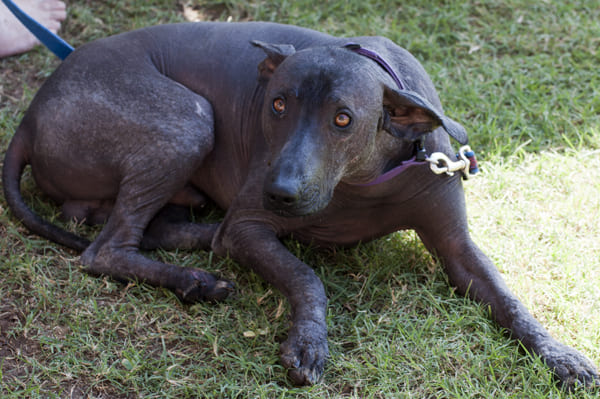
Health Issues of Xoloitzcuintli Dogs
Xoloitzcuintli dogs are generally healthy and hardy, but like all breeds, they can be prone to specific health issues. It’s important for owners to be aware of these potential health concerns and to provide proper care and regular veterinary check-ups. Some of the health issues associated with Xoloitzcuintli dogs include:
- Dental Problems: Xolos can be prone to dental issues, such as tooth decay and gum disease. Regular dental care, including brushing their teeth and providing dental chews, is essential to maintain their oral health.
- Sunburn: The hairless variety of Xolos is vulnerable to sunburn due to their exposed skin. When outdoors, especially in sunny weather, they should be protected with pet-friendly sunscreen and provided with shaded areas.
- Skin Conditions: Some Xolos may develop skin conditions, such as acne, rashes, or irritations. Proper hygiene and moisturizing can help prevent these issues.
- Skin Allergies: Xoloitzcuintlis can be sensitive to allergens that may lead to skin allergies. Identifying and addressing allergens, along with veterinary guidance, can help manage these allergies.
- Orthopedic Problems: Xolos, especially the larger ones, can be susceptible to orthopedic issues like hip dysplasia and luxating patellas. Regular exercise and maintaining a healthy weight can help reduce the risk of these problems.
- Eye Conditions: Some Xolos may be prone to eye conditions, including cataracts, progressive retinal atrophy, and glaucoma. Regular eye exams are important to detect and address these issues early.
- Dermoid Sinus: This is a congenital condition in which a small tube-like structure forms under the skin. It’s important to identify and treat this condition promptly, as it can lead to more serious health problems if left untreated.
- Ear Infections: Like many other breeds, Xolos can develop ear infections, especially if their ears are not properly cleaned and maintained. Regular ear cleaning and inspections are recommended.
- Hypothyroidism: Some Xolos may experience hypothyroidism, a condition where the thyroid gland doesn’t produce enough hormones. This can lead to various health issues, and it can be managed with medication.
- Heart Conditions: While not common, Xolos may be at risk for certain heart conditions. Regular veterinary check-ups can help detect and address any heart issues early.
Xoloitzcuintli Teeth
Xoloitzcuintli dogs, like all dogs, have a set of 42 teeth, including incisors, canines, premolars, and molars. Their dental health is essential, and owners should pay attention to their teeth. Regular dental care, such as brushing their teeth with a dog-specific toothbrush and toothpaste, is important to prevent dental issues like tartar buildup, gum disease, and tooth decay. Providing dental chews and toys can also help maintain their oral health. Dental health is crucial to their overall well-being and comfort.
Xoloitzcuintli Lifespan
The average lifespan of a Xoloitzcuintli typically ranges from 12 to 15 years. This is a relatively long life expectancy for a dog breed. Proper care, including a balanced diet, regular exercise, regular veterinary check-ups, and a safe and loving environment, can contribute to a Xoloitzcuintli’s longevity.
Food for Polydactyl Dogs
Some common Food options for Polydactyl Dogs:
| Food Type | Description |
|---|---|
| High-Quality Dog Food | Provide a well-balanced commercial dog food suitable for their age, size, and activity level. Look for options with real meat as the main ingredient. |
| Fresh Fruits and Vegetables | Offer fresh fruits and vegetables as occasional treats or supplements. Options like apples, carrots, and green beans can be healthy choices. Always remove seeds and pits and avoid toxic foods. |
| Lean Protein Sources | Lean proteins such as chicken, turkey, and fish are excellent for polydactyl dogs. Avoid fatty cuts and excessive seasoning. |
| Whole Grains | Incorporate whole grains like brown rice, quinoa, or oats for a good source of carbohydrates. These provide energy and fiber. |
| Omega-3 Fatty Acids | Foods rich in omega-3 fatty acids, such as salmon or flaxseed, can promote healthy skin and coat. |
| Avoid Harmful Foods | Keep chocolate, grapes, raisins, onions, and foods containing xylitol away from polydactyl dogs, as these can be toxic. |
Xoloitzcuintli Dog Popular Names
Xoloitzcuintli Dog Popular Names:
| Male Xoloitzcuintli Names | Female Xoloitzcuintli Names |
|---|---|
| Max | Bella |
| Rocky | Luna |
| Charlie | Maya |
| Coco | Chica |
| Diego | Frida |
| Pablo | Xochitl |
| Aztec | Cali |
| Pancho | Mocha |
| Tito | Paloma |
| Pepito | Sombra |
Xoloitzcuintli Video
Conclusion:
In conclusion, the Xoloitzcuintli, or Mexican Hairless Dog, is a remarkable and ancient breed with a rich history dating back thousands of years. Known for their unique appearance, loyalty, and affectionate nature, Xolos make wonderful companions for those who are willing to meet their specific care requirements. Whether you’re drawn to their hairless or coated varieties, the Xoloitzcuintli’s cultural significance and adaptability have made them increasingly popular as both loving pets and guardians of their family’s well-being.
Frequently Asked Questions on Xoloitzcuintli Dogs:
-
What is a Xoloitzcuintli?
A Xoloitzcuintli, commonly known as the Mexican Hairless Dog or Xolo, is a unique and ancient dog breed originating from Mexico. They are characterized by their hairless or coated skin and have a rich history dating back over 3,000 years.
-
Are Xoloitzcuintlis hypoallergenic?
While Xolos are often considered hypoallergenic due to their minimal shedding, they can still produce allergens in their saliva, dander, and urine. Allergies can vary among individuals, so spending time with a Xolo before bringing one home is advisable for allergy sufferers.
-
What sizes do Xoloitzcuintli come in?
Xoloitzcuintlis come in three main sizes: toy, miniature, and standard. Toy Xolos are the smallest, while standard Xolos are the largest. This size variety makes them suitable for various living situations.
-
Do Xoloitzcuintlis require a lot of grooming?
Hairless Xolos require minimal grooming due to their lack of hair. Coated Xolos need regular brushing to maintain their coats. Both varieties benefit from skincare to prevent dryness and sunburn.
-
What is the temperament of Xoloitzcuintli dogs?
Xolos are known for their loyalty, affection, and protective nature. They form strong bonds with their families and may be reserved around strangers. Early socialization is crucial to ensure they are well-adjusted and confident.
-
How long do Xoloitzcuintlis live?
The average lifespan of a Xoloitzcuintli typically ranges from 12 to 15 years. Proper care and attention to their health can contribute to a long and healthy life.
-
Are Xoloitzcuintlis good with children and other pets?
Xolos are generally good with children and other pets when properly socialized from a young age. Their loyal and protective nature can make them wonderful family dogs.
-
Can I find Xoloitzcuintli dogs for adoption?
Yes, Xoloitzcuintli dogs are available for adoption. You can check local animal shelters, rescue organizations, or breed-specific rescues for Xolos in need of loving homes.
-
Do Xoloitzcuintlis have any specific health concerns?
Xolos may be prone to dental issues, skin conditions, sunburn, and certain hereditary health concerns like hip dysplasia. Regular veterinary check-ups and attentive care can help manage these issues.
-
Is the Xoloitzcuintli a good fit for every family?
Xolos can be great companions for the right families. They are well-suited for those who are committed to their care, including their unique grooming needs and socialization requirements. Consider your lifestyle and preferences to determine if a Xoloitzcuintli is the right fit for your family.
Recommended –








